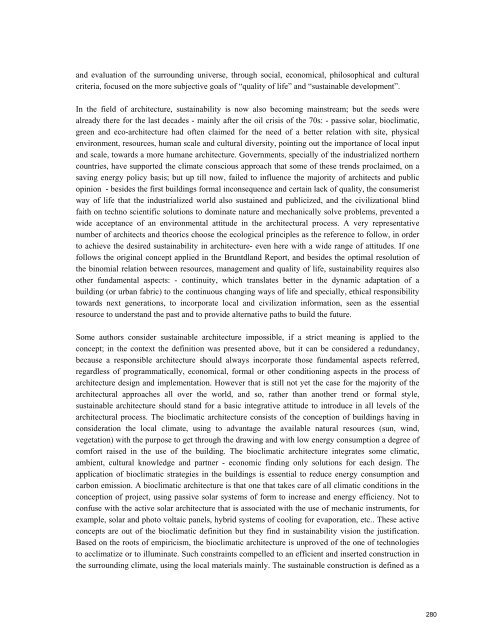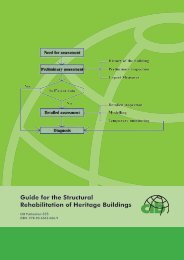CIB W116âSmart and Sustainable Built Environments - Test Input
CIB W116âSmart and Sustainable Built Environments - Test Input
CIB W116âSmart and Sustainable Built Environments - Test Input
Create successful ePaper yourself
Turn your PDF publications into a flip-book with our unique Google optimized e-Paper software.
<strong>and</strong> evaluation of the surrounding universe, through social, economical, philosophical <strong>and</strong> cultural<br />
criteria, focused on the more subjective goals of “quality of life” <strong>and</strong> “sustainable development”.<br />
In the field of architecture, sustainability is now also becoming mainstream; but the seeds were<br />
already there for the last decades - mainly after the oil crisis of the 70s: - passive solar, bioclimatic,<br />
green <strong>and</strong> eco-architecture had often claimed for the need of a better relation with site, physical<br />
environment, resources, human scale <strong>and</strong> cultural diversity, pointing out the importance of local input<br />
<strong>and</strong> scale, towards a more humane architecture. Governments, specially of the industrialized northern<br />
countries, have supported the climate conscious approach that some of these trends proclaimed, on a<br />
saving energy policy basis; but up till now, failed to influence the majority of architects <strong>and</strong> public<br />
opinion - besides the first buildings formal inconsequence <strong>and</strong> certain lack of quality, the consumerist<br />
way of life that the industrialized world also sustained <strong>and</strong> publicized, <strong>and</strong> the civilizational blind<br />
faith on techno scientific solutions to dominate nature <strong>and</strong> mechanically solve problems, prevented a<br />
wide acceptance of an environmental attitude in the architectural process. A very representative<br />
number of architects <strong>and</strong> theorics choose the ecological principles as the reference to follow, in order<br />
to achieve the desired sustainability in architecture- even here with a wide range of attitudes. If one<br />
follows the original concept applied in the Bruntdl<strong>and</strong> Report, <strong>and</strong> besides the optimal resolution of<br />
the binomial relation between resources, management <strong>and</strong> quality of life, sustainability requires also<br />
other fundamental aspects: - continuity, which translates better in the dynamic adaptation of a<br />
building (or urban fabric) to the continuous changing ways of life <strong>and</strong> specially, ethical responsibility<br />
towards next generations, to incorporate local <strong>and</strong> civilization information, seen as the essential<br />
resource to underst<strong>and</strong> the past <strong>and</strong> to provide alternative paths to build the future.<br />
Some authors consider sustainable architecture impossible, if a strict meaning is applied to the<br />
concept; in the context the definition was presented above, but it can be considered a redundancy,<br />
because a responsible architecture should always incorporate those fundamental aspects referred,<br />
regardless of programmatically, economical, formal or other conditioning aspects in the process of<br />
architecture design <strong>and</strong> implementation. However that is still not yet the case for the majority of the<br />
architectural approaches all over the world, <strong>and</strong> so, rather than another trend or formal style,<br />
sustainable architecture should st<strong>and</strong> for a basic integrative attitude to introduce in all levels of the<br />
architectural process. The bioclimatic architecture consists of the conception of buildings having in<br />
consideration the local climate, using to advantage the available natural resources (sun, wind,<br />
vegetation) with the purpose to get through the drawing <strong>and</strong> with low energy consumption a degree of<br />
comfort raised in the use of the building. The bioclimatic architecture integrates some climatic,<br />
ambient, cultural knowledge <strong>and</strong> partner - economic finding only solutions for each design. The<br />
application of bioclimatic strategies in the buildings is essential to reduce energy consumption <strong>and</strong><br />
carbon emission. A bioclimatic architecture is that one that takes care of all climatic conditions in the<br />
conception of project, using passive solar systems of form to increase <strong>and</strong> energy efficiency. Not to<br />
confuse with the active solar architecture that is associated with the use of mechanic instruments, for<br />
example, solar <strong>and</strong> photo voltaic panels, hybrid systems of cooling for evaporation, etc.. These active<br />
concepts are out of the bioclimatic definition but they find in sustainability vision the justification.<br />
Based on the roots of empiricism, the bioclimatic architecture is unproved of the one of technologies<br />
to acclimatize or to illuminate. Such constraints compelled to an efficient <strong>and</strong> inserted construction in<br />
the surrounding climate, using the local materials mainly. The sustainable construction is defined as a<br />
280

















